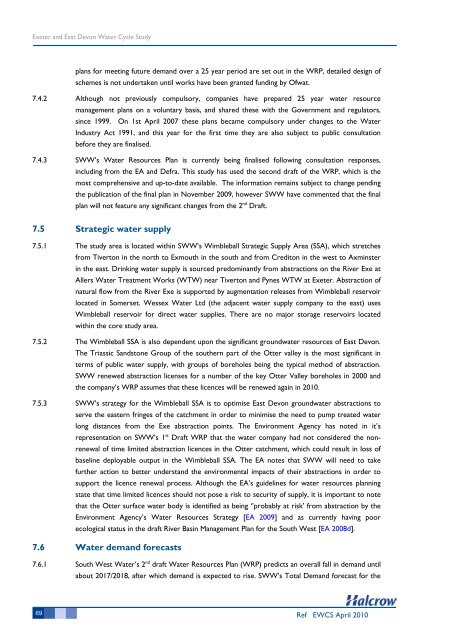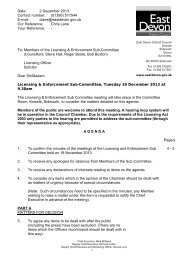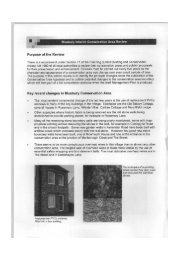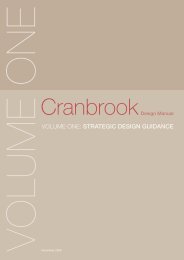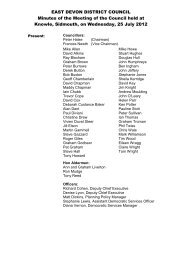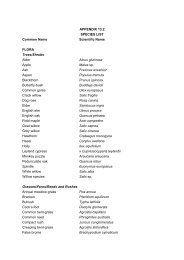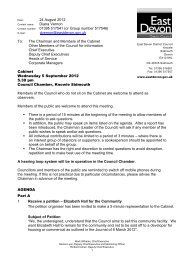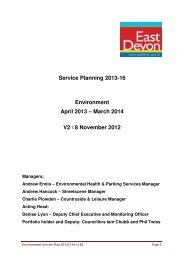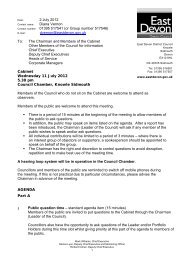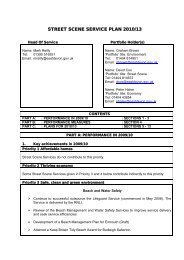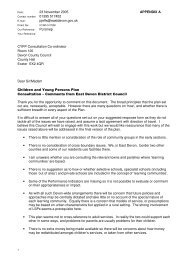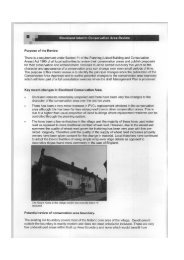Water Cycle Study - East Devon District Council
Water Cycle Study - East Devon District Council
Water Cycle Study - East Devon District Council
Create successful ePaper yourself
Turn your PDF publications into a flip-book with our unique Google optimized e-Paper software.
Exeter and <strong>East</strong> <strong>Devon</strong> <strong>Water</strong> <strong>Cycle</strong> <strong>Study</strong><br />
plans for meeting future demand over a 25 year period are set out in the WRP, detailed design of<br />
schemes is not undertaken until works have been granted funding by Ofwat.<br />
7.4.2 Although not previously compulsory, companies have prepared 25 year water resource<br />
management plans on a voluntary basis, and shared these with the Government and regulators,<br />
since 1999. On 1st April 2007 these plans became compulsory under changes to the <strong>Water</strong><br />
Industry Act 1991, and this year for the first time they are also subject to public consultation<br />
before they are finalised.<br />
7.4.3 SWW’s <strong>Water</strong> Resources Plan is currently being finalised following consultation responses,<br />
including from the EA and Defra. This study has used the second draft of the WRP, which is the<br />
most comprehensive and up-to-date available. The information remains subject to change pending<br />
the publication of the final plan in November 2009, however SWW have commented that the final<br />
plan will not feature any significant changes from the 2 nd Draft.<br />
7.5 Strategic water supply<br />
7.5.1 The study area is located within SWW’s Wimbleball Strategic Supply Area (SSA), which stretches<br />
from Tiverton in the north to Exmouth in the south and from Crediton in the west to Axminster<br />
in the east. Drinking water supply is sourced predominantly from abstractions on the River Exe at<br />
Allers <strong>Water</strong> Treatment Works (WTW) near Tiverton and Pynes WTW at Exeter. Abstraction of<br />
natural flow from the River Exe is supported by augmentation releases from Wimbleball reservoir<br />
located in Somerset. Wessex <strong>Water</strong> Ltd (the adjacent water supply company to the east) uses<br />
Wimbleball reservoir for direct water supplies. There are no major storage reservoirs located<br />
within the core study area.<br />
7.5.2 The Wimbleball SSA is also dependent upon the significant groundwater resources of <strong>East</strong> <strong>Devon</strong>.<br />
The Triassic Sandstone Group of the southern part of the Otter valley is the most significant in<br />
terms of public water supply, with groups of boreholes being the typical method of abstraction.<br />
SWW renewed abstraction licenses for a number of the key Otter Valley boreholes in 2000 and<br />
the company’s WRP assumes that these licences will be renewed again in 2010.<br />
7.5.3 SWW’s strategy for the Wimbleball SSA is to optimise <strong>East</strong> <strong>Devon</strong> groundwater abstractions to<br />
serve the eastern fringes of the catchment in order to minimise the need to pump treated water<br />
long distances from the Exe abstraction points. The Environment Agency has noted in it’s<br />
representation on SWW’s 1 st Draft WRP that the water company had not considered the nonrenewal<br />
of time limited abstraction licences in the Otter catchment, which could result in loss of<br />
baseline deployable output in the Wimbleball SSA. The EA notes that SWW will need to take<br />
further action to better understand the environmental impacts of their abstractions in order to<br />
support the licence renewal process. Although the EA’s guidelines for water resources planning<br />
state that time limited licences should not pose a risk to security of supply, it is important to note<br />
that the Otter surface water body is identified as being ‘’probably at risk’ from abstraction by the<br />
Environment Agency’s <strong>Water</strong> Resources Strategy [EA 2009] and as currently having poor<br />
ecological status in the draft River Basin Management Plan for the South West [EA 2008d].<br />
7.6 <strong>Water</strong> demand forecasts<br />
7.6.1 South West <strong>Water</strong>’s 2 nd draft <strong>Water</strong> Resources Plan (WRP) predicts an overall fall in demand until<br />
about 2017/2018, after which demand is expected to rise. SWW’s Total Demand forecast for the<br />
69 Ref EWCS April 2010


